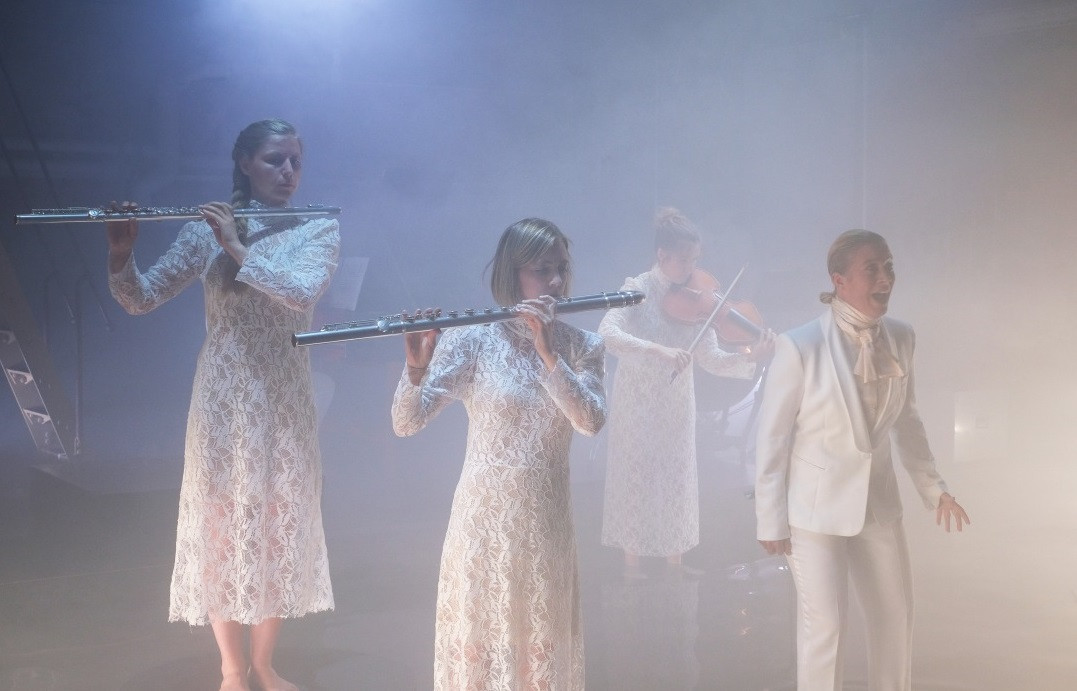
Nothing can be comfortable
‘Salvatore Sciarrino’s music is hardly there,’ wrote the British critic Philip Clark, ‘and yet, it is prodigiously detailed, packed with event and itchy, restless energy.’ No surprise that festival director and composer Christian Winther Christiansen – whose own works lie even further down the reductive road than Sciarrino’s and are possibly even more intricate, itchy and ‘hardly there’ – should include a piece by the Italian purveyor of skittish suggestion in the 2018 incarnation of Klang.
Sciarrino wrote his miniature singspiel Aspern in 1978, using chopped up fragments of Lorenzo da Ponte’s libretto for Mozart’s The Marriage of Figaro to reflect on various aspects of Henry James’s half-story in which a prying narrator figure seeks access to letters written by Percy Bysshe Shelley to his lover Claire Clairmont, Mary Shelley’s stepsister. The 8-movement Aspern Suite (1987) is derived from the opera; not ostensibly a stage work, but probably just as theatrical given the fact that Sciarrino’s whole idea of theatre tends to rest on musical tension rather than narrative event.
Silences of Venice
James’s setting is Venice. It couldn’t be anywhere else. It is the Venice not just of Da Ponte but of Nicolas Roeg and Thomas Mann; a place that literature suggests might exist more in the imagination than in reality (a scenario science has its own theories on) and an unsettling accomplice for Sciarrino’s ghostly breathing and trilling, for his frightened dead ends – those ‘cadences that couldn’t be bothered to turn up’ in Clark’s words. James’s series of events concern a primary story that we will never hear; the letters in question are burned before the protagonist gets his hands on them. With no surtitles in this performance produced by Scenatet, non-Italians in the audience got little idea of Da Ponte’s meaning from soprano Signe Asmussen beyond what her voice could convey musically and what Sciarrino’s flutes, strings, harpsichord and percussion could tell us by wrapping themselves around it, leading it on or dragging it down.
But it’s often in Sciarrino’s silences – and the hinterlands of that silence, where someone might be breathing down a piece of metal or rubbing some horsehair on a string but then again, might not be – that his music seems at its heaviest. From Anna Berit Asp Christiansen’s beautiful staging inside the blacked-out former train shed Pumpestationen we heard the sound of the water in which the musicians stood and walked, full of loneliness and fear, a very Venetian almost-silence. Mikkel Jensen’s lighting design was just as striking and pregnant with secrets, like the seductive darkness of that standing water and of Sciarrino’s entire sonic universe.
Nothing is real
The composer’s ‘Ouvertura’ scurries like Mozart’s for The Marriage of Figaro but viewed from the wrong end of a telescope. Later on he uses his soprano to reference classical Italian vocal decorations and if Asmussen didn’t give us total precision and gleam in the miniature fireworks Sciarrino flings up into the darkness, then she certainly showed us fear. She resembled a lost creature, unable to elaborate on her first thoughts as though trapped in the ambiguity of a dream or a hallucination: it’s not that those cadences can’t be bothered to turn up, it’s that the antecedent didn’t actually exist so nor can the consequence. When nothing is real, nothing can be finished. Nothing can be healed. Nothing can be comfortable.
Not even, for example, the otherwise friendly ‘Passegiata’ (we hear it, according to Sciarrino’s scoring, from the other side of an obsessively fluttering instrumental gauze); nor the shapely aria that follows, ‘Continua la passegiata’, where the soprano takes the lead in a phantom instrumental procession where flutes and strings whistle and scrape on contradictory harmonics. By ‘Non più andrai’ the soprano is spitting out reactive maxims and somehow getting into an expressive stride. But this proves an illusion too. It’s the instrumental group that starts to coalesce, and the effect is the creation of an even stranger, more arcane domain against whose fuming exhalations and distant rumblings the soprano is silenced – unable even to spew out one of those stillborn ariosos we were becoming acclimatized to.
When nothing is real, nothing can be finished. Nothing can be healed. Nothing can be comfortable.
Ceremonial control
Asmussen said much with her eyes and Christensen’s staging had her character progressively and cruelly isolated, ignored by the instrumentalists placed all around, her apparent gestures of love and friendship rejected or mocked (there was one moment of particularly effective choreography in which the flautists Anna Melander and Marie Sønderskov appeared to castigate her with unison physical movements like braying horses).
That underlined Sciarrino’s tendency to embed his instruments in the psychological drama, suggesting human attributes in them. All the same, this might not be an opera ‘for one’ but when words come only from the soprano any sense of binary tension – the idea of two or more characters of questionable origin, motive and sexual relationship grappling with what they are and are not being told by each other and by the past – is understandably more difficult to harness than in a more developed piece such as Sciarrino’s two-hander Luci mie traditrici (1998). There, the built-in silences are supercharged by their existence within an actual, physical confrontation between two characters (infidelity and murder come in handy).
Aspern Suite limits its own storytelling in direct reference to the untold stories of James’s work. But we don’t get much semblance of the author’s character development. Perhaps the idea of loneliness – of a single being unable to maintain traction with ideas, things, people and even music – is a good surrogate for a more obvious scenario in which the tension is suspended between two characters. The tension of isolation was well utilized as a concept in this production but it was undermined by one consistent choreographic pattern: the instrumentalists walking around the performing area with a uniform, slow solemnity. Over time, it became more ceremonial and yogic than intense, devious, dreamy or untrustworthy. It diminished the often erratic, intangible progress of the music by projecting a physical rhythm over the top of it that was overtly ordered, consistent and in-control.
The mystery
The reason we felt the gears grinding is that Sciarrino’s music breathes naturally, even at its most pained or stuttering. When the composer sets up an apparatus, only he can disrupt or derail it, which fills a choreographed, physical manifestation of it with potential pitfalls (those momentary movements from the two flautists worked so well because they didn’t last long enough to feel like anything but momentary reactions to the music sounding over the top of them).
Scenatet’s lighting, video art and misty, watery darkness linked arms with the quietly melodramatic atmosphere on which Aspern’s events gain import and implication, and through which we might begin to imagine what they mean. Asmussen’s gaze, out into the middle distance or aimed with piercing ferocity at her instrumental colleagues, was full of meaning too. There have probably been more intense, sharp and imposing performances of Sciarrino’s calligraphic score. But in this one, the mystery of the piece became not just its biggest asset but its most saddening one. Maybe those of us who started out wanting surtitles had forgotten we were hearing the suite, not watching the singspiel.



